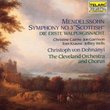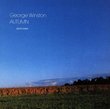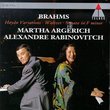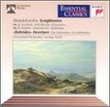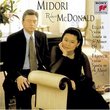| All Artists: Franz Joseph Haydn, Neville Marriner, Academy of St. Martin-in-the-Fields Title: Haydn: The Paris Symphonies Nos. 82-87 Members Wishing: 0 Total Copies: 0 Label: Philips Release Date: 1/18/1994 Genre: Classical Styles: Historical Periods, Classical (c.1770-1830), Symphonies Number of Discs: 2 SwapaCD Credits: 2 UPC: 028943872720 |
Search - Franz Joseph Haydn, Neville Marriner, Academy of St. Martin-in-the-Fields :: Haydn: The Paris Symphonies Nos. 82-87
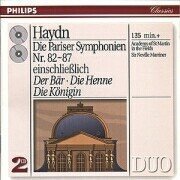 | Franz Joseph Haydn, Neville Marriner, Academy of St. Martin-in-the-Fields Haydn: The Paris Symphonies Nos. 82-87 Genre: Classical
|
Larger Image |
CD DetailsSimilarly Requested CDs
|
CD ReviewsAn absolute must-have. pissedhobbit | Seattle, WA | 03/03/2002 (5 out of 5 stars) "These six symphonies, collectively called "Paris", are actually the first six which Haydn wrote to be played at the d'Olympique, with 88 - 92 following. (No. 92, "Oxford", is stylistically more often associated with the first "London" set, but was actually written for Paris.) I've owned this recording for about three years and it is one to which I often turn. The sound quality is remarkable for an analog recording, the tempi feel "just right", and the playing is superb. The Symphony no. 85 is particularly good here, with its powerful introduction and first movement, recalling the French Overture style, but with a difference (isn't that always the case with Haydn?): Here, Haydn injects the theme from his "Farewell" Symphony as a lead-in to his second subject set and to great effect! (Ironically, this was the favorite symphony of Marie Antoinette, someone to whom history would soon be bidding farewell...did Haydn know something?) Marriner makes the most of this and many other delicious moments in all these works. The wind playing is subtle, yet beautiful during solo sections and there is plenty of sound coming from the cello/bass/bassoon sections (which is often overlooked and underplayed in recordings of music prior to Beethoven). Overall, I prefer the sound and interpretation of this recording (and other Marriner/St. Martin recordings) to many of the heavy, ponderous recordings by modern symphony orchestras and to all of the shrill, glassy, deliberately thin-sounding recordings with "unmusical-because-we-know-better" interpretations made by period instrument groups. I highly recommend this recording to anyone who enjoys music of this period and especially to those who love the beautiful, witty, and soulful Franz Joseph Haydn." Haydn at his very best Radu Zlatanovici | Berkeley, CA United States | 12/13/2001 (5 out of 5 stars) "I have been a big Haydn "fan" for many years. Calling the music "beautiful" would be a gross understatement. I was particularly impresed by the less famous symphonies 84,86 and 87. When you write 104 symphonies, some might think the individual value of one symphony tends to decrease and some repetitions might occur. This is not the case with Haydn. Each piece has its own distinctive uniqueness. Every single piece on this CD (and by Haydn in general) is a masterpiece. These 2 CDs are possibly some of the best Haydn recordings ever made. Sir Neville Mariner is doing a fabulous job and the orchestra is respnding superbly. Technically - although the original recording is analog (and yes, there is some audible noise from the analog tape), the studio guys managed to keep the noise at an acceptable low level without inducing that boombox-like sound of over-processed tracks. Overall, a must have for Haydn fans. Definitely 5 stars." Exploring the Haydn Symphonies -- the Paris Symphonies Robin Friedman | Washington, D.C. United States | 03/10/2005 (5 out of 5 stars) "Haydn's set of six "Paris" Symphonies, no. 82 --87, composed in 1785 -- 1786 represent a turning point in his career. Up to that time, Haydn had composed for the Esterhazy family. He was employed in the magnificent Esterhazy palace as the court composer. But his works had been circulated widely throughout Europe, and he enjoyed a great reputation as a composer. Thus, in 1784 the board of directors of the Concerts de la Loge Olympique, Paris, asked Haydn for six symphonies. This set is the result.
The Paris symphonies are larger more complex works than Haydn's earlier symphonies for the Esterhazy court. They use a variety of forms, explore many moods, make extensive use of winds and brass, and display a self-confidence and self-mastery that remain a revelation to hear. Yet, Haydn developed slowly and carefully as a composer. It is inspiring to remember how these symphonies were the outgrowth of Haydn's long years of development of the symphonic form. I have been listening to many of Haydn's earlier symphonies on Naxos, but turned to this set on Phillips by the Academy of St. Martin in the Fields conducted by Sir Neville Marriner for the Paris symphonies. This is an outstanding compiliation, radiant, lively, and full of attention to detail. There are competitors to this CD, including low-priced disks, but you will not go wrong with this set. Of the six Paris symphonies, three have nicknames, for better or for worse: the "Bear" no. 82, the "Hen" no. 83, and the "Queen" no. 85. The symphony no. 82 is a festive, joyful work with a great deal of brass, flute, bassoon and tympani enlivening the opening movement. The second movement is a set of variations, while the third movement is a stately minuet with a whimsical trio. The dancing "bear" appears in the finale in a drone in the lower strings. The g-minor symphony, no.83, the only one of the set in a minor key, opens in a severe, serious manner its nickname of "hen" notwithstanding. The nickname derives from a theme in the oboe in the first movement. The slow movement is mostly serene and peaceful but takes a dramatic turn in the middle while the minuet is flowing and graceful. The finale is in the major key, and is lively and humorous in the style of a round. The symphony no. 85, "La Reine" in B-flat major probably remains my favorite of this set. It opens with a slow introduction followed by a lively, graceful theme. Note how Haydn uses a rising scale figure both in the introduction and in the body of the movement. The second theme of the opening movement is based on the first movement of Haydn's earlier "Farewell" symphony. The second movement of "La Reine" is a theme and variations on a French folk song, while the third is a minuet, both graceful and regal. The finale, is a rapid triumphant vivace. The symphony no 84 in E-flat also has a solemn slow introduction, featuring the horn followed by a quick light opening movement. The slow movement is based on simple variations of a sinuous theme stated in the lower strings. The third movement is a stately minuet which flows seamlessly into the trio, while the finale, vivace, brings the work to a galant close. The symphony no. 86 in D is, together with "La Reine" the masterwork of the set. Haydn's sketches of this work survive and show the effort he put into the seemingly smooth surface of this symphony. The work begins with a lengthy slow introduction followed by a brisk allegro and a lyrical second theme. Haydn makes extensive use of winds in the symphony. The second movement bears the unusual marking "cappricio." It is in free-form and is serious in character. The minuet is rather uptempo with a trio that features a solo for the bassoon and is like a little dance. The Haydn scholar Karl Geringer has described the finale of this work as an "Italian opera buffa". "A musical comedy" he writes "with its flirtatous girl, its miserly old bachelor, and hilarious disguises seems to come to life in this amusing piece." (Geringer, "Haydn" at 300) The final work of the set is the symphony no. 87 in A. The opening movement is in a galant, busy style. The lovely second movement features solo passages for flute, bassoon, and oboe. The stately minuet again features the use of winds in the trio while the finale begins quietly and works up to a big close. These symphonies are great works of music and exemplify Haydn's hard-won maturity and success as a composer. Both the listener new to classical music and the lifelong music lover will treasure these performances." |

 Track Listings (12) - Disc #1
Track Listings (12) - Disc #1
